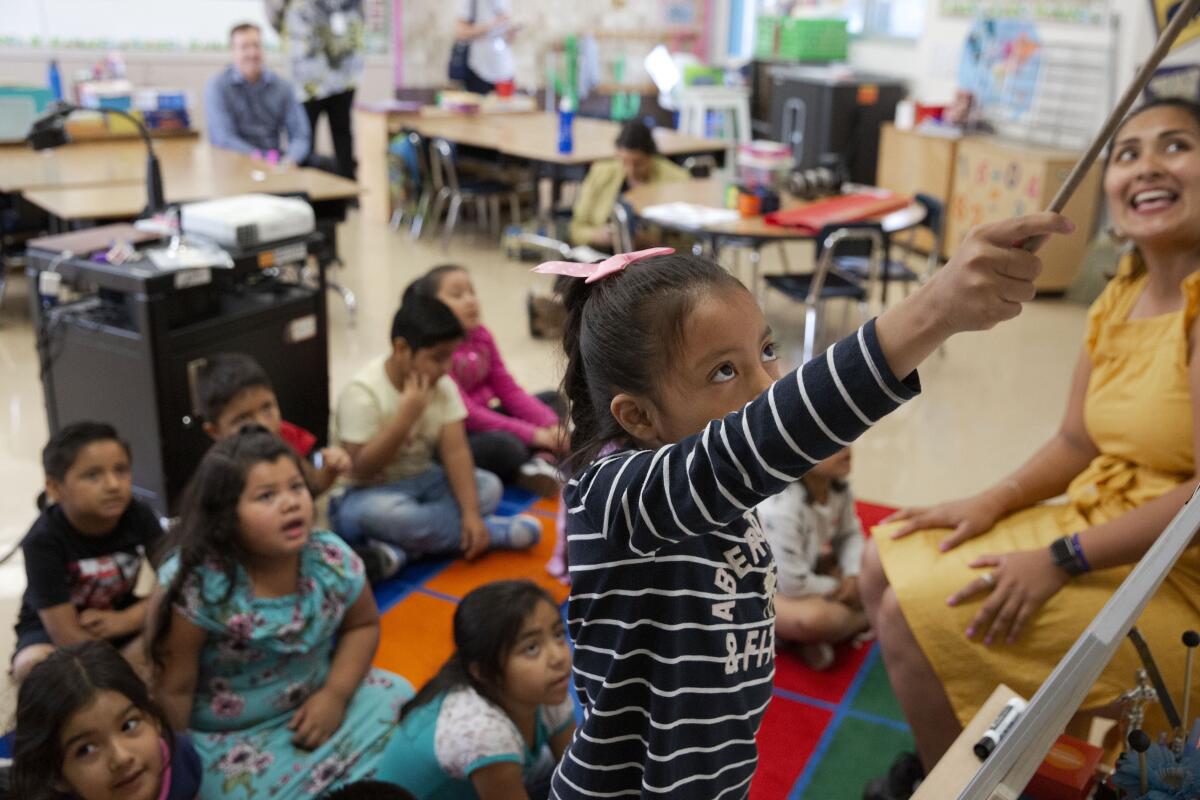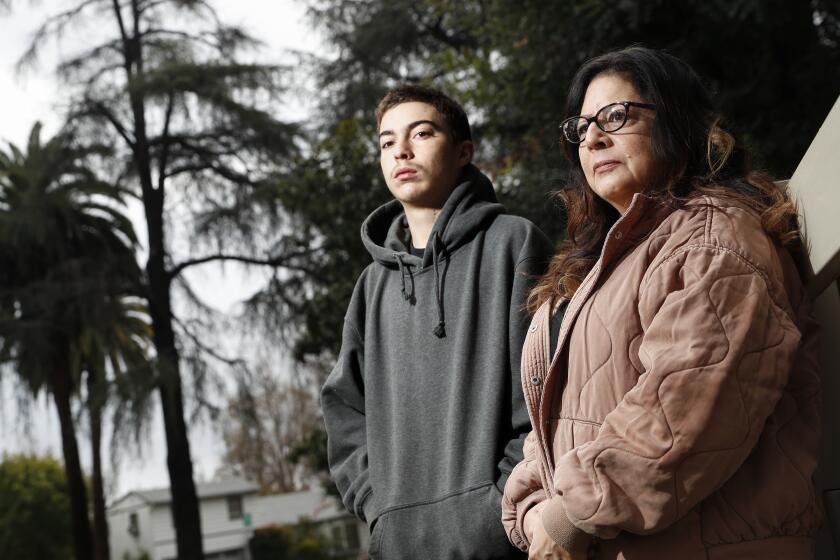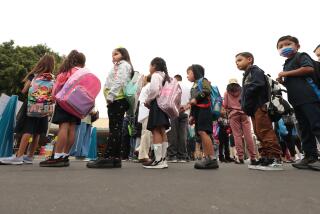California public school enrollment continues decline, still reeling from pandemic plunge

Enrollment at California public schools has continued to decline this academic year, without any recovery from the steep drops seen during the pandemic — although the pace of the decrease has slowed.
Enrollment for the 2022-23 school year fell 0.69% — representing 40,000 students — from the previous year, bringing the total to 5,852,544, according to newly released state data.
This year’s percentage decline is higher than those of each of the five years prior to the pandemic but a substantial improvement on the two years most affected by COVID-19: 2020-21 and 2021-22.
The latest numbers show that “student enrollment is beginning to stabilize with increased enrollment in kindergarten and grades seven and eleven,” according to a statement from the California Department of Education. But for nine of the 13 grade levels, enrollment was lower than last year.
“I know the state frame is: Enrollment has stabilized. But at some level, that’s missing the point, which is that these kids aren’t coming back,” said Thomas Dee, a professor at Stanford Graduate School of Education. “We haven’t seen — and are unlikely to see anytime in the near future — a bounce back from the substantial loss in public school enrollment that occurred over the pandemic.”
The numbers should be viewed in a national context, according to Assemblyman Kevin McCarty (D-Sacramento), chair of the Budget Subcomittee on Education Finance.
“The nation saw a steep withdrawal from formal education during the pandemic — a sharp decline in all school enrollment compared to natural declines in birth rates — and we still don’t know when or if these families will return,” said McCarty.
If students are doing well, then a modest and gradual drop in enrollment can be managed effectively, experts and officials said. But a sharp enrollment decline or a significant steady one — the state has recently experienced both — poses challenges: Districts eventually have to lay off workers and curtail programs, and schools may have to close.
California has long touted its low expulsion rates. But vague reporting requirements may be allowing schools to mask expulsions as transfers.
The issue is likely to surface in a substantial way in about two years — when COVID-19 aid has been exhausted. But a few California school systems already face problems.
Centinela Valley Union High School District in the South Bay, for example, operates three comprehensive high schools. The district postponed reducing staff during the pandemic in hopes that enrollment would rebound, said Supt. Stephen Nellman. Instead, the number of students continued to shrink.
The district sent out 105 layoff notices to employees represented by the teachers union, including staff with significant seniority.
At a recent board meeting, more than 200 students, parents and staff members marched in pouring rain, then packed the board meeting room in Lawndale for an emotionally charged hearing in which speakers accused district officials of mismanagement.
“We are a canary in the coal mine,” Nellman said.
At Los Angeles Unified, the state’s largest school system, the financial picture appears different, with a large budget surplus that seems able to support significant raises and hiring.
But with declining enrollment, “districts have to face the difficult question of closing schools and which schools to close,” Dee said. “Past experience tells us that these are challenges that just rend the fabric of communities, because parents don’t want to lose their neighborhood schools.”
The disruption to education when a child changes schools can be consequential, Dee said.
“As it often plays out, many of our most vulnerable learners are often asked to switch schools — and maybe not directed toward one of our higher-performing schools,” he said.
Although the drops in enrollment have not been broken out by demographics, they reflect overall trends in California. The state experienced a population drop of more than 500,000 people between April 2020 and July 2022. California has been seeing declines for years, with the pandemic pushing even more people to move to other parts of the country, experts say.
California lost more people than any state besides New York between April 2020 and July 2022, data show. Texas gained nearly 900,000 people in the same period.
“California, like the rest of the nation, is grappling with a new normal brought on by the pandemic,” said Assembly Budget Chair Phil Ting (D-San Francisco).
In some instances, secondary students left school during the pandemic, taking jobs to support their families or looking after younger siblings while parents worked. Some have likely since earned a high school degree or GED certificate even if they have not been officially accounted for in the K-12 system, said Maria Clayton, a spokesperson for the state Department of Education.
Some young children, meanwhile, were held out of public school during the remote-learning phase of the pandemic and have not returned.
Private school enrollment rose slightly last year — by about 6,000 students. Charter school enrollment is up about 7,500 this year but declined by 12,600 last year. Home-schooling declined by about 9,000 students. (Home-schooling numbers are self-reported. A parent could be home-schooling without filing a required affidavit with the state.)
Neither researchers nor public officials have put forward anything close to a full accounting for the pandemic decline at public schools.
In 2020-21, enrollment plummeted by 160,478 students, or 2.6%. The majority of California students spent most of that year in remote lessons. The drop the following year was smaller — 110,283 students, or 1.84% — but still historically large, even though in-person school had resumed.
Compared with those two pandemic years, this year’s figures are vastly better. But there’s a caveat: The leap in kindergarten enrollment is misleading.
Enrollment in kindergarten looks like it increased by more than 25,000 students — more than five times the gain of any other grade. However, this figure was boosted by including a newly expanded grade: transitional kindergarten for 4-year-olds.
The state did not provide separate figures on how many students are in kindergarten and how many are in the expanded pool of 4-year-olds. Thus, it’s not clear whether the kindergarten figure of 496,000 represents real growth at all.
State demographers estimate that there are at least 1 million 4- and 5-year-olds in California, so the data suggest that fewer than half are in public school. Attendance for that age group is optional in California — Gov. Gavin Newsom vetoed mandatory kindergarten. But most state leaders, including Newsom, say the extra schooling is especially important for children whose families suffered most from the pandemic.
A March report from the state Senate estimated that the number of 4-year-olds in public school had increased by only 11,000 students over the last three years, even though “roughly 65,000 additional children are eligible” due to gradual traditional kindergarten expansion.
Recent estimates from the California legislative analyst’s office suggest that about 91,000 4-year-olds are in traditional kindergarten this year, said Bruce Fuller, a UC Berkeley professor of education and public policy.
“The underlying truth is disappointing growth in preschool slots for young children,” said Fuller. “But there’s great potential for future growth if local schools can find additional teachers and win state dollars to renovate classrooms for young children.”
Earlier this school year, L.A. school officials reported a similar pattern: continued enrollment decline somewhat offset by the addition of transitional kindergarten.
Among the most disturbing numbers in the state data is a 9% increase in the number of homeless students — that’s 15,584 additional children.
This number could reflect that with the return of in-person services, “districts are better at identifying homeless youth,” said Dee, or it could be that the pandemic and other factors exacerbated the problem.
“You could imagine that many housing-insecure youth were effectively truant or skipping school and are now finding their way back,” he noted.
More to Read
Start your day right
Sign up for Essential California for news, features and recommendations from the L.A. Times and beyond in your inbox six days a week.
You may occasionally receive promotional content from the Los Angeles Times.









